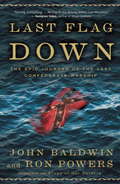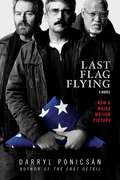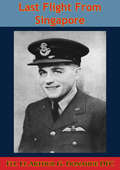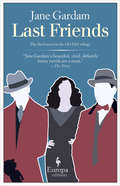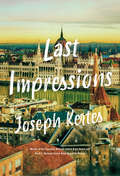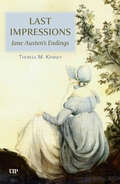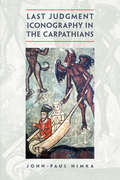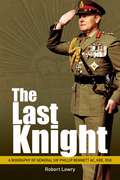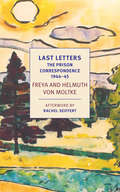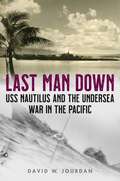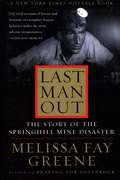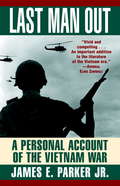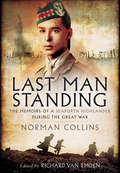- Table View
- List View
Last Duke Standing: A Historical Romance (A Royal Match #1)
by Julia LondonFans of Bridgerton will love the this sparkling, witty, and sexy new series from New York Times bestselling author Julia London! With a young future queen in the market for a husband, and the charming—and opinionated—Scottish lord tasked to introduce her to the ton&’s most eligible bachelors.Charming. Cheeky. Cunning.When Crown Princess Justine of Wesloria is sent to England to learn the ropes of royalty, she falls under the tutelage of none other than Queen Victoria herself. Justine&’s also in the market for a proper husband—one fit to marry the future queen of Wesloria.Because he knows simply everyone, William, Lord Douglas (the notoriously rakish heir to the Duke of Hamilton seat in Scotland, and decidedly not husband material), is on hand as an escort of sorts. William has been recruited to keep an eye on the royal matchmaker for the Weslorian prime minister, tasked to ensure the princess is matched with a man of quality…and one who will be sympathetic to the prime minister&’s views.As William and Justine are forced to scrutinize an endless parade of England&’s best bachelors, they become friends. But when the crowd of potential grooms is steadily culled, what if William is the last bachelor standing?
Last Flag Down
by Ron Powers John BaldwinAs the Confederacy felt itself slipping beneath the Union juggernaut in late 1864, the South launched a desperate counteroffensive to shatter the U. S. economy and force a standoff. Its secret weapon? A state-of-the-art raiding ship whose mission was to prowl the world’s oceans and sink the U. S. merchant fleet. The raider’s name was Shenandoah, and her executive officer was Conway Whittle, a twenty-four-year-old warrior who might have stepped from the pages of Arthurian legend. Whittle would share command with a dark and brooding veteran of the seas, Capt. James Waddell, and together with a crew of strays, misfits, and strangers, they would spend nearly a year sailing two-thirds of the way around the globe, destroying dozens of Union ships and taking more than a thousand prisoners, all while continually dodging the enemy. Then, in August of 1865, a British ship revealed the shocking truth to the men of Shenandoah: The war had been over for months, and they were now being hunted as pirates. What ensued was an incredible 15,000-mile journey to the one place the crew hoped to find sanctuary, only to discover that their fate would depend on how they answered a single question. Wondrously evocative and filled with drama and poignancy,Last Flag Downis a riveting story of courage, nobility, and rare comradeship forged in the quest to achieve the impossible.
Last Flag Flying: A Novel
by Darryl PonicsánNow a major movie starring Steve Carell, Bryan Cranston, and Laurence Fishburne, directed by Richard Linklater!Darryl Ponicsan's debut novel The Last Detail was named one of the best of the year and widely acclaimed, catapulting him to fame when it was first published. The story of two career sailors assigned to escort a young seaman from Norfolk to the naval prison in Portsmouth, New Hampshire—and of the mayhem that ensues—was made into an award-winning movie starring Jack Nicholson. Last Flag Flying, set thirty-four years after the events of The Last Detail, brings together the same beloved characters—Billy Bad-Ass Buddusky, Mule Mulhall, and Meadows—to reprise the same journey but under very different circumstances. Now middle-aged, Meadows seeks out his former captors in their civilian lives to help him bury his son, a Marine killed in Iraq, in Arlington National Cemetery. When he learns that the authorities have told him a lie about the circumstances of his son's death, he decides, with the help of the two others, to transport him home to Portsmouth. And so begins the journey, centered around a solemn mission but, as in the first book, a protest against injustice and celebration of life too, at once irreverent, funny, profane, and deeply moving.Last Flag Flying is now a major movie from Amazon Studios, directed by Richard Linklater and starring Bryan Cranston, Steve Carell, and Laurence Fishburne.
Last Flight
by Kristen Mai GiangA Junior Library Guild Gold Standard On April 24, 1975 the last flight out of Saigon, Vietnam carried over 400 people to the United States, six days before Saigon’s surrender to the North Vietnamese Army. Kristen Giang was a little girl, on that flight with family, and here in this story she shares all the emotions of the decision to flee from the perspective of someone eight years old; Playing a game of space-explorers to protect herself and her sister’s eyes from tear gas; sneaking a stuffed animal into the family’s overstuffed suitcase for comfort. Dow Phumiruk’s tender illustrations let anyone feel the excitement and the ultimate hopefulness of this amazing true story. P R A I S E "Deeply touching… A tender and powerful portrait of a harrowing, historic event." —Booklist "Mai Giang’s sensory-filled prose gently and evocatively communicates a personal wartime story. Phumiruk’s clean, soft illustrations, done in Photoshop and pencil, bring to life a gamut of emotions…A moving and illuminating story of family, war, courage, and newfound home." —Kirkus "Giang’s affecting, powerful recounting of her family’s escape from Saigon in 1975 renders a largely unexplored moment in history intimate and urgent." —BCCB
Last Flight From Saigon [Illustrated Edition] (USAF Southeast Asia Monograph Series #4)
by Lt.-Col. A. J. C. LavalleIllustrated with over 30 maps, diagrams and photosThe Southeast Asia Monograph Series is designed and dedicated to telling the story of USAF's participation in the Vietnam War. This monograph, the sixth in the Series, adds another exciting chapter to our continuing effort to bring forth and highlight the dedication, courage, and professionalism of the U.S. airman in combat. The primary intent of this series is to emphasize and dramatize the human aspects of this long and frustrating struggle, straying somewhat away from the cold hard statistics of "tons of bombs dropped" and "structures destroyed," etc., frequently the headliners in historical presentations."Last Flight From Saigon" is an exciting and moving account of how all our Services, as well as several civilian agencies, pulled together to pull-off the largest aerial evacuation in history-what many have referred to as a modern day Dunkirk. The three authors, intimately involved with the evacuation from beginning to end, have carefully pieced together an amazing story of courage, determination and American ingenuity. Above all, it's a story about saving lives; one that is seldom told in times of war. All too often, critics of armed conflict make their targets out to be something less than human, bent on death and destruction. One need only study the enormity of the effort and cost that went into the "evacuation of Saigon," and the resultant thousands of lives that were saved, to realize that the American fighting man is just as capable, and more eager, to save lives than he is in having to wage war.
Last Flight From Singapore [Illustrated Edition]
by Flt. Lt. Arthur G. Donahue DFCIncludes 20 illustrations.Arthur "Art" Gerald Donahue, a native of Minnesota, bravely entered the fray of the Second World War as volunteer pilot in the Royal Air Force by falsely claiming to be a Canadian in 1940. He was already an experienced pilot before he took off in his Spitfire in 64 Squadron based at RAF Kenley, and then 71 Squadron. His experiences and victories during the Battle of Britain are recounted in his first book "Yankee In A Spitfire" but suffice it to say he flew with great skill and courage as one of the "Few". After a period of brief leave in America he was transferred to the Far East with 258 Squadron, a part of the belated effort to reinforce Singapore. In this book he recounts his adventures in the air over Singapore and Sumatra in the chaotic fighting that saw the British troops routed by a brilliant offensive by the Japanese. Surviving the overwhelming odds in the air, the author managed to escape back to England via India; but was listed as missing in action in 1942."Donahue makes no attempt either to dramatize or underplay his experiences. He tells them in a simple, unvarnished manner, much as if he were sitting down with some friends back home. The result is pretty close to what the real thing must have been."--New York Times
Last Flight of the Luftwaffe
by Adrian WeirThe account of one of the most extraordinary stories to come from the closing days of the Second World War.Desperate times drive determined men to desperate measures. In April 1945, their cause already clearly lost, an ill-assorted, ill-equipped group of Luftwaffe crew decided on one final 'death or glory' kamikaze mission - their trage an incoming USAAF Eighth Air Force bomber formation, their only weapons their aircraft.Adrian Weir has researched this remarkable flight to retell it minute by minute: a hopeless gesture of immense courage, thrilling as the reader flies in the cockpit with the German pilots towards the unstoppable aircarft of the Mighty Eighth. Including accounts from the survivors of the mission, this is one of the most extraordinary stories to come from the closing days of the Second World War.
Last Flight of the Luftwaffe: The Suicide Attack On The Eigth Air Force, 7 April 1945 (Sven Hassel War Classics)
by Adrian WeirThe account of one of the most extraordinary stories to come from the closing days of the Second World War.Desperate times drive determined men to desperate measures. In April 1945, their cause already clearly lost, an ill-assorted, ill-equipped group of Luftwaffe crew decided on one final 'death or glory' kamikaze mission - their trage an incoming USAAF Eighth Air Force bomber formation, their only weapons their aircraft.Adrian Weir has researched this remarkable flight to retell it minute by minute: a hopeless gesture of immense courage, thrilling as the reader flies in the cockpit with the German pilots towards the unstoppable aircarft of the Mighty Eighth. Including accounts from the survivors of the mission, this is one of the most extraordinary stories to come from the closing days of the Second World War.
Last Friends (Old Filth Trilogy #3)
by Jane Gardam“The satisfying conclusion to Gardam’s Old Filth trilogy offers exquisite prose, wry humor, and keen insights into aging and death” (The New Yorker).While Old Filth introduced readers to Sir Edward Feathers, his dreadful childhood, and his decades-long marriage, The Man in the Wooden Hat was his wife Betty’s story. Last Friends is Terence Veneering’s turn. His beginnings were not those of the usual establishment grandee. Filth’s hated rival in court and in love is the son of a Russian acrobat marooned in the English midlands and a local girl. He escapes the war and later emerges in the Far East as a man of panache and fame. The Bar treats his success with suspicion: Where did this handsome, brilliant Slav come from? This exquisite story of Veneering, Filth, and their circle tells a bittersweet tale of friendship and grace and of the disappointments and consolations of age. They are all, finally, each other’s last friend as this magnificent series ends with the deep and abiding satisfaction that only great literature provides.“[Gardam’s] prose sparkles with wit, compassion and humor. She keeps us entertained, and she keeps us guessing. Be thankful for her books. Be thankful for this trilogy, which is ultimately an elegy, created with deep affection.” —The Washington Post“Restores us to an era rich in spectacle and bristling with insinuation and intrigue. Vivid, spacious, superbly witty, and refreshingly brisk . . . the story (and the author) will endure.” —The Boston Globe“All three Gardam books are beautifully written but it’s a pleasure to note that Last Friends is the most enjoyable, the funniest and the most touching.” —National Post
Last Gentleman Standing
by Jane Ashford"Jane Ashford's characters are true to their times, yet they radiate the freshness of today."—Historical Novel Reviews A fun, witty Regency romance from bestselling author Jane Ashford. Young heiress Lady Elisabeth Elham has no need for marriage, but warding off London's most charming suitors is easier said than done. Miss Elisabeth Elham is an unlikely heiress. She never knew the curmudgeonly uncle who died suddenly and left her a fortune. She's proud, outspoken and independent—a definite challenge for London's fortune hunting suitors.As various determined gentlemen vie for her attention at balls, routs, picnics and parties, Elisabeth finds herself embroiled with a charming rake, a mysterious nabob, and an elegant neighbor. This would all be great fun, if only she wasn't so fascinated by the one man in London who's not trying to woo her...Originally titled Bluestocking, this story has been unavailable for over 25 years.
Last Hope Island: Britain, Occupied Europe, and the Brotherhood That Helped Turn the Tide of War
by Lynne OlsonA groundbreaking account of how Britain became the base of operations for the exiled leaders of Europe in their desperate struggle to reclaim their continent from Hitler, from the New York Times bestselling author of Citizens of London and Those Angry Days When the Nazi blitzkrieg rolled over continental Europe in the early days of World War II, the city of London became a refuge for the governments and armed forces of six occupied nations who escaped there to continue the fight. So, too, did General Charles de Gaulle, the self-appointed representative of free France. As the only European democracy still holding out against Hitler, Britain became known to occupied countries as “Last Hope Island.” Getting there, one young emigré declared, was “like getting to heaven.” In this epic, character-driven narrative, acclaimed historian Lynne Olson takes us back to those perilous days when the British and their European guests joined forces to combat the mightiest military force in history. Here we meet the courageous King Haakon of Norway, whose distinctive “H7” monogram became a symbol of his country’s resistance to Nazi rule, and his fiery Dutch counterpart, Queen Wilhelmina, whose antifascist radio broadcasts rallied the spirits of her defeated people. Here, too, is the Earl of Suffolk, a swashbuckling British aristocrat whose rescue of two nuclear physicists from France helped make the Manhattan Project possible. Last Hope Island also recounts some of the Europeans’ heretofore unsung exploits that helped tilt the balance against the Axis: the crucial efforts of Polish pilots during the Battle of Britain; the vital role played by French and Polish code breakers in cracking the Germans’ reputedly indecipherable Enigma code; and the flood of top-secret intelligence about German operations—gathered by spies throughout occupied Europe—that helped ensure the success of the 1944 Allied invasion. A fascinating companion to Citizens of London, Olson’s bestselling chronicle of the Anglo-American alliance, Last Hope Island recalls with vivid humanity that brief moment in time when the peoples of Europe stood together in their effort to roll back the tide of conquest and restore order to a broken continent.Advance praise for Last Hope Island“A rip-roaring saga of hairbreadth escape, espionage, and resistance during World War II, Lynne Olson’s Last Hope Island salvages the forgotten stories of a collection of heroic souls from seven countries overrun by Hitler who find refuge in Churchill’s London and then seek payback in ways large and small. In thrilling fashion, Olson shows us that hell hath no fury like a small country scorned.”—Erik Larson, New York Times bestselling author of Dead Wake “Lynne Olson is a master storyteller, and she brings her great gifts to this riveting narrative of the resistance to Hitler’s war machine. You will be thrilled and moved—and enraged, saddened, and shocked—by the courage and steadfastness, human waste and stupidity, carelessness and nobility, of an epic struggle. Last Hope Island is a smashing good tale.”—Evan Thomas, New York Times bestselling author of Being Nixon “A powerful and surprising account of how figures from Nazi-occupied Europe found Great Britain an essential shield and sword in the struggle against Hitler. This is a wonderful work of history, told in Olson’s trademark style.”—Jon Meacham, Pulitzer Prize–winning author of American Lion
Last House: A Novel
by Jessica Shattuck"An ambitious historical epic that doubles as an intimate family saga. Jessica Shattuck captures and connects it all—the imperial ambitions of the postwar generation, the rebellion of their offspring in the Sixties, and the fallout we’re still sifting through today. . . . This is a wide-ranging novel to savor.” — TOM PERROTTAFrom the New York Times bestselling author of The Women in the Castle comes a sweeping story of a nation on the rise, and one family’s deeply complicated relationship to the resource that built their fortune and fueled their greatest tragedy, perfect for fans of The Dutch House and Great Circle.It’s 1953, and for Nick Taylor, WWII veteran turned company lawyer, oil is the key to the future. He takes the train into the city for work and returns to the peaceful streets of the suburbs and to his wife, Bet, former codebreaker now housewife, and their two children, Katherine and Harry. Nick comes from humble origins but thanks to his work for American Oil, he can provide every comfort for his family, including Last House, a secluded country escape. Deep in the Vermont mountains, the Taylors are free from the stresses of modern life. Bet doesn’t have to worry about the Russian H-bombs that haunt her dreams, and the children roam free in the woods. Last House is a place that could survive the end of the world.It’s 1968, and America is on the brink of change. Protestors fill the streets to challenge everything from the Vietnam War to racism in the wake of MLK’s shooting—to the country's reliance on Big Oil. As Katherine makes her first forays into adult life, she’s caught up in the current of the time and struggles to reconcile her ideals with the stable and privileged childhood her Greatest Generation parents worked so hard to provide. But when the Movement shifts in a more radical direction, each member of the Taylor family will be forced to reckon with the consequences of the choices they’ve made for the causes they believed in.Spanning multiple generations and nearly eighty years, Last House tells the story of one American family during an age of grand ideals and even greater downfalls. Set against the backdrop of our nation’s history, this is an emotional tour de force that digs deeply into questions of inheritance and what we owe each other—and captures to stunning effect the gravity of time, the double edge of progress, and the hubris of empire.
Last Impressions
by Joseph KertesHow can you say goodbye forever when you've left an important secret unspoken?"I'll tell you what I'm going to do," Zoltan said. "When I die, I'll leave my luck to you."Zoltan Beck is dying. His devoted but long-suffering sons, Ben and Frank, are trying to prepare themselves and their families for Zoltan's eventual departure...but they can't quite bring themselves to believe that the end is really at hand, and neither can Zoltan himself. The head of a family marked by war and tragedy for decades, he "can't stand to be in a room with a miserable person" and has done his best to keep the pain of his refugee past from his beloved children. But as he faces the end of his life, he discovers a heartbreaking secret from the War that will ultimately bring the family together--or irrevocably disrupt it. Set in both mid-20th century Hungary and contemporary Toronto, this is a deeply moving novel that revels in the energy of its extraordinary characters. It is the story of lost love and newfound connections, of a father and his sons desperately reaching out to bridge an ever-widening gap...even as their time together ebbs away.
Last Impressions: Jane Austen's Endings
by Theresa M. KenneyJane Austen’s conclusions have often perplexed her readers, who at times perceive her novels’ endings as hasty or overly simplistic. However, a closer examination reveals that her final chapters are meticulously crafted, serving as critical touchstones that redefine the entire narrative. Last Impressions offers an in-depth analysis of the literary strategies Austen employs to conclude her novels. This work explores recurring techniques, such as securing parental consent, the absence of dramatized scenes, and the use of rhetorical devices like Socratic irony and metalepsis, uncovering meaningful patterns that highlight Austen’s artistry. By illuminating the intentionality behind the endings of all six of Austen’s major novels, as well as her epistolary novella Lady Susan, this book provides valuable insights into her narrative architecture. In a literary landscape that has frequently dismissed Austen’s conclusions, Last Impressions asserts that her final chapters demand critical engagement, challenging readers to reconsider their interpretations and appreciate her enduring complexity.
Last Judgment Iconography in the Carpathians
by John-Paul HimkaFew subjects in Christianity have inspired artists as much as the last judgment. Last Judgment Iconography in the Carpathians examines images of the last judgment from the fifteenth century to the present in the Carpathian mountain region of Ukraine, Poland, Slovakia, and Romania, as a way to consider history free from the traditional frameworks and narratives of nations. Over ten years, John-Paul Himka studied last-judgment images throughout the Carpathians and found a distinctive and transnational blending of Gothic, Byzantine, and Novgorodian art in the region.Piecing together the story of how these images were produced and how they developed, Himka traces their origins on linden boards and their evolution on canvas and church walls. Tracing their origins with monks, he follows these images' increased popularity as they were commissioned by peasants and shepherds whose tastes so shocked bishops that they ordered the destruction of depictions of sexual themes and grotesque forms of torture. A richly illustrated and detailed account of history through a style of art, Last Judgment Iconography in the Carpathians will find a receptive audience with art historians, religious scholars, and slavists.
Last Knight: A Biography of General Sir Phillip Bennett AC, KBE, DSO (Big Sky Publishing Ser.)
by Robert LowryGeneral Sir Phillip Bennett is a good example of what makes a great leader. With a good combination of innate personal qualities, education, broad experience and the hardening that comes with survival on the battlefield he prospered. As a young officer he survived the first and most perilous year of the Korean War, including the Battle of Kapyong.
Last Letters: The Prison Correspondence between Helmuth James and Freya von Moltke, 1944-45
by Rachel SeiffertAvailable for the first time in English, a moving prison correspondence between a husband and wife who resisted the Nazis.Tegel prison, Berlin, in the fall of 1944. Helmuth James von Moltke is awaiting trial for his leading role in the Kreisau Circle, one of the most important German resistance groups against the Nazis. By a near miracle, the prison chaplain at Tegel is Harald Poelchau, a friend and co-conspirator of Helmuth and his wife, Freya. From Helmuth’s arrival at Tegel in late September 1944 until the day of his execution by the Nazis on January 23, 1945, Poelchau would carry Helmuth’s and Freya’s letters in and out of prison daily, risking his own life. Freya would safeguard these letters for the rest of her long life, much of it spent in Norwich, VT, from 1960 until her death in 2010.Last Letters is a profoundly personal record of the couple’s love, faith, and courage in the face of fascism. Written during the final months of World War II, the correspondence is at once a collection of love letters written in extremis and a historical document of the first order. Published to great acclaim in Germany, this volume now makes this deeply moving correspondence available for the first time in English.
Last Light: How Six Great Artists Made Old Age a Time of Triumph
by Richard LacayoOne of the nation&’s top art critics shows how six great artists made old age a time of triumph by producing some of the greatest work of their long careers—and, in some cases, changing the course of art history.Ordinarily, we think of young artists as the bomb throwers. Monet and Renoir were still in their twenties when they embarked on what would soon be called Impressionism, as were Picasso and Braque when they ventured into Cubism. But your sixties and the decades that follow can be no less liberating if they too bring the confidence to attempt new things. Young artists may experiment because they have nothing to lose; older ones because they have nothing to fear. With their legacies secure, they&’re free to reinvent themselves…sometimes with revolutionary results. Titian&’s late style offered a way for pigment itself—not just the things it depicted—to express feelings on the canvas, foreshadowing Rubens, Frans Hals, 19th-century Impressionists, and 20th-century Expressionists. Goya&’s late work enlarged the psychological territory that artists could enter. Monet&’s late waterlily paintings were eventually recognized as prophetic for the centerless, diaphanous space developed after World War II by abstract expressionists like Jackson Pollock and Phillip Guston. In his seventies, Matisse began to produce some of the most joyful art of the 20th century, especially his famous cutouts that brought an ancient craft into the realm of High Modernism. Hopper, the ultimate realist, used old age on occasion to depart into the surreal. And Nevelson, the patron saint of late bloomers, pioneered a new kind of sculpture: wall-sized wooden assemblages made from odds and ends she scavenged from the streets of Manhattan. Though these six artists differed in many respects, they shared one thing: a determination to go on creating, driven not by the bounding energies of youth but by the ticking clock that would inspire them to produce some of their greatest masterpieces.
Last Man Down: The Fireman's Story: The Heroic Account of How Pitch Picciotto Survived the Collapse of the Twin Towers
by FDNY Battalion C Richard 'Pitch' PicciottoThe No. 1 bestselling true story of Battalion Commander Richard Picciotto who, on 11 September, survived the collapse of the North Tower of the World Trade Center.On September 11th, Battalion Commander Richard 'Pitch' Picciotto was the highest ranking fire department commander in the twin towers when the North Tower fell. Pitch and his men were on the 17th floor racing upward when the world seemed to explode around them. From his intimate knowledge of the Towers gained during service after the 1993 WTC bombing Pitch was able to lead the firefighters to an alternative stairwell to floor 12 where they were met with a horrifying sight - more than 50 workers too crippled, too old, or too weak to have made their way out on their own. Pitch ordered his firefighters to form a human chain and pushed and cajoled them down the stairs. They were in the 7th floor stairwell when the tower fell, and Pitch and a handful of survivors woke to find themselves buried on the landing of floor 2. This is the story of how Pitch Picciotto led his men and the survivors to safety.
Last Man Down: USS Nautilus and the Undersea War in the Pacific
by David W. JourdanSS-168—the USS Nautilus—was the flagship of Submarine Division 12 operating out of Pearl Harbor throughout World War II. It was commissioned July 1, 1930, before international naval treaties limited future submarine size, and thus was among the largest submarines in the U.S. fleet. Over a football field in length and displacing 4,000 tons submerged, the boat was able to carry a large crew, ample cargo, two dozen torpedoes, cruiser-sized six-inch caliber guns, and cruise as far as 25,000 miles. She could dive to three hundred feet—though her crew was known to take her deeper. Throughout 1942–45 the Nautilus engaged the enemy in fourteen different patrols, from the Battle of Midway to the liberation of the Philippines, earning fourteen battle stars. Her skipper, William H. Brockman, Jr., received not one but three Navy Crosses for heroism, the first for fighting through 42 depth charges at Midway. Nautilus did everything a submarine can do and was involved in most of the major actions of the Pacific theater. In Last Man Down, historical events documented in deck logs and patrol reports are told through the voices of the men who lived them.
Last Man Out
by Melissa Fay GreeneThe deepest coal mine in North America was notoriously unpredictable. One late October evening in 1958, it "bumped" - its rock floors heaving up and smashing into rock ceilings. A few miners staggered out, most of the 174 on shift did not.Nineteen men were trapped, plunged into darkness, hunger, thirst, and hallucination. As days and nights passed, the survivors began to hope for death by gas rather than from thirst. Above ground, journalists and families stood in despairing vigil, as rescuers brought out scores of the dead. The hope of finding life undergound faded and families made funeral preparations.Then, a miracle: Rescuers stumbled across a broken pipe leading to a cave of survivors, then a second group was discovered.A media circus followed. Ed Sullivan, then the state of Georgia, invited survivors to visit. Publicity, politics, and segregation sorted the men differently than they had ordered themselves. Underground, the one black survivor nursed a dying man; in Atlanta, Governor Marvin Griffin said: "I will not shake hands with a Negro."If every great writer has one tale of peril, heroism, and survival, Last Man Out is Melissa Fay Greene's. Using long-lost stories and interviews with survivors, Greene has reconstructed the drama of their struggle to stay alive
Last Man Out: A Personal Account of the Vietnam War
by James E. Parker Jr."I WAS AMONG THE FIRST MEN IN, AND I WAS THE LAST MAN OUT. " In Vietnam, at both the start and finish of the conflict, 2d Lt. James E. Parker Jr. saw the war as few men did. Now, with uncommon insight and raw honesty, he captures the stark realities of jungle combat, heavy casualties, and heroic sacrifice. From the tight confines of a VC-occupied Cu Chi tunnel to bloody firefights in areas that hardcore VC and NVA vets had controlled for decades, Parker relives the rain, the heat, the horror, the pain--and the anguish of kneeling beside a buddy whose blood turnd the soil black as he lays dying. Vietnam exacted a very high price. Parker pays tribute to the men who paid it.
Last Man Out: Surviving the Burma-Thailand Death Railway: A Memoir
by H. Robert CharlesAn American Marine recounts his ordeal as a World War II POW forced by the Japanese to build the railway immortalized in The Bridge on the River Kwai.From June 1942 to October 1943, more than 100,000 Allied POWs who had been forced into slave labor by the Japanese died building the infamous Burma-Thailand Death Railway, an undertaking immortalized in the film The Bridge on the River Kwai. One of the few who survived was American Marine H. Robert Charles, who describes the ordeal in vivid and harrowing detail in Last Man Out. The story mixes the unimaginable brutality of the camps with the inspiring courage of the men, such as a Dutch Colonial Army doctor whose skill and knowledge of the medicinal value of wild jungle herbs saved the lives of hundreds of his fellow POWs, including the author.Praise for Last Man Out“A remarkable story, long overdue, of the treatment of POW’s captured by Japan.” —Arthur L. Maher, USN, Senior officer to survive sinking of the USS Houston, POW of the Japanese in World War II“In World War II, to move materials and troops from Japan to Burma by avoiding the perilous sea route around the Malay Peninsula, the Japanese military built a railroad through the jungles of Thailand and Burma at great human cost to its prisoner laborers. Last Man Out is an effective addition to the history of this tragedy.” —Library Journal
Last Man Standing: Mort Sahl and the Birth of Modern Comedy
by James CurtisA Times Literary Supplement 2017 Book of the YearOn December 22, 1953, Mort Sahl (1927–2021) took the stage at San Francisco's hungry i and changed comedy forever. Before him, standup was about everything but hard news and politics. In his wake, a new generation of smart comics emerged—Shelley Berman, Mike Nichols and Elaine May, Lenny Bruce, Bob Newhart, Dick Gregory, Woody Allen, and the Smothers Brothers, among others. He opened up jazz-inflected satire to a loose network of clubs, cut the first modern comedy album, and appeared on the cover of Time surrounded by caricatures of some of his frequent targets such as Dwight Eisenhower, Richard Nixon, Adlai Stevenson, and John F. Kennedy. Through the extraordinary details of Sahl's life, author James Curtis deftly illustrates why Sahl was dubbed by Steve Allen as “the only real political philosopher we have in modern comedy.”Sahl came on the scene the same year Eisenhower and Nixon entered the White House, the year Playboy first hit the nation's newsstands. Clad in an open collar and pullover sweater, he adopted the persona of a graduate student ruminating on current events. “It was like nothing I'd ever seen,” said Woody Allen, “and I've never seen anything like it after.” Sahl was billed, variously, as the Nation's Conscience, America's Only Working Philosopher, and, most tellingly, the Next President of the United States. Yet he was also a satirist so savage the editors of Time once dubbed him “Will Rogers with fangs.”Here, for the first time, is the whole story of Mort Sahl, America's iconoclastic father of modern standup comedy. Written with Sahl's full cooperation and the participation of many of his friends and contemporaries, it delves deeply into the influences that shaped him, the heady times in which he soared, and the depths to which he fell during the turbulent sixties when he took on the Warren Commission and nearly paid for it with his career.
Last Man Standing: The Memiors of a Seaforth Highlander During the Great War
by Norman CollinsA first-hand account of World War I by a nineteen-year-old Englishman who led a platoon into the carnage of the Battle of the Somme. While researching his excellent earlier book: Veterans of World War I, author Richard Van Emden encountered a fascinating personality of that long-ago conflict. After witnessing German naval attacks on British civilians, Norman Collins enlisted in the Seaforth Highlanders of the 51st Highland Division, even though he was under age. Collins fought at the battles of Beaumont Hamel, Arras, and Passchendaele, and was wounded several times. Collins lived to be 100 and had an unusually detailed collection of letters, documents, illustrations and photographs. Richard Van Emden has written a moving biography of a unique personality at war, and his long life after the dramatic events of his youth.&“This is a harrowing tale of battle, loss and the horrors of war.&” —Scotland Magazine&“His collection of letters, photographs and the record of interviews as an old man are a treasure trove of information on Western Front fighting.&” —British Army Review/Soldier Magazine&“Enthralling memoir. These letters form the freshest part of this book, full of detail about kit and food that obsessed soldiers but which do not find a place in the history books.&” —Who Do You Think You Are?&“This is one of the last great first-person memoirs of the Great War. Extraordinary diary, letter collection and photos.&” —Scottish Legion News

